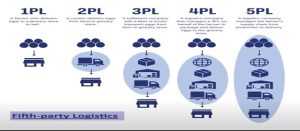

In the dynamic world of logistics and supply chain management, companies have various options for managing their logistics operations. These options are commonly referred to as 1PL (First Party Logistics) to 5PL (Fifth Party Logistics). Each of these logistics models has distinct characteristics, benefits, and complexities. Understanding these can help businesses in India make informed decisions to enhance efficiency and competitiveness.

Logistics is the backbone of any business, playing a critical role in ensuring that products reach customers in a timely and cost-effective manner. As businesses grow and markets expand, managing logistics becomes increasingly complex. This complexity has given rise to different logistics models, each catering to specific needs and offering unique advantages.
1PL refers to in-house logistics operations managed entirely by the company itself. This means the company is responsible for all aspects of logistics, including transportation, warehousing, and distribution.
2PL involves outsourcing specific logistics functions to a single service provider, typically for transportation services.
3PL refers to the comprehensive outsourcing of logistics functions to a third-party provider. This includes services such as transportation, warehousing, inventory management, and distribution.
4PL involves strategic coordination and management of the entire supply chain on behalf of the client. A 4PL provider acts as a single point of contact, overseeing all logistics activities.
5PL takes logistics management a step further by incorporating advanced technologies and data analytics to enhance supply chain visibility, forecasting, and decision-making.
Become a Logistician : https://urbxknowledgepark.com/programmes/logistics-management-courses/
Conclusion
The evolution from 1PL to 5PL reflects the increasing complexity and sophistication in logistics management. Companies in India, ranging from local manufacturers to multinational corporations, can choose the logistics model that best suits their needs, considering factors such as control, scalability, expertise, and technological adoption. By understanding these different logistics models, businesses can strategically enhance their supply chain operations, improve efficiency, and stay competitive in an ever-changing market.
Embracing the right level of logistics management can significantly impact a company’s ability to meet customer demands, reduce costs, and drive growth. As the logistics landscape continues to evolve, leveraging advanced technologies and specialized expertise will be key to achieving supply chain excellence.
More Reference : https://www.linkedin.com/pulse/evolution-logistics-providers-from-1pl-5pl-legacy-express-trucking-dtu0c/
